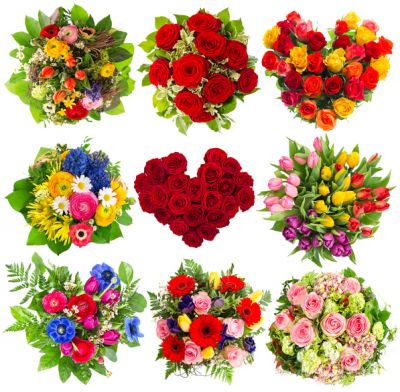 Planning your wedding requires much attention to detail, and that includes the flowers. If you’re doing this on your own, you’ll need to choose a florist and set a budget limit. Before that, you’ll also need to determine which types of floral arrangements to include for your big day. A guide to the types of arrangements typically used by the wedding party, family members and other participants should help you in pulling together the details and successfully making choices with which you and your future spouse will be happy.
Planning your wedding requires much attention to detail, and that includes the flowers. If you’re doing this on your own, you’ll need to choose a florist and set a budget limit. Before that, you’ll also need to determine which types of floral arrangements to include for your big day. A guide to the types of arrangements typically used by the wedding party, family members and other participants should help you in pulling together the details and successfully making choices with which you and your future spouse will be happy.
Your Wedding Party
The floral arrangements needed for your wedding party largely depend on who will be included and their attire. If either you or your intended will be wearing a bridal dress, you’ll need a bouquet. Attendants in dresses (traditionally the bridesmaids) will carry smaller bouquets. If either you or your future spouse will be wearing a suit, a tuxedo or some other form of menswear, you’ll need a boutonniere, which is usually one large bloom that’s sometimes accompanied by tinier sprays
of flowers and greenery. Your wedding attendants who’ll be donning menswear will sport their own boutonnieres. Finally, you’ll need arrangements for children who are part of the ceremony, such as those scattering flower petals or serving as the ring bearer.
Parents, Grandparents and Ushers
Besides your wedding party, there are other individuals you’ll need to think about when planning your floral arrangements. Depending on their preferences and attire, your parents and grandparents will need corsages, nosegays or boutonnieres. Corsages, traditionally worn with female formalwear, are small sprays of flowers worn either attached to the dress or worn on the wrist like a bracelet. Nosegays are very small bouquets, and they might be a good alternative for those who don’t want to pin anything to their attire or would have trouble wearing a wrist corsage for several hours. Additionally, you may elect for your ushers to wear small boutonnieres or smaller corsages.
What About the Officiant?
When planning your ceremonial flowers, it’s a good idea to think about your officiant. If he or she is not a professional minister or another kind of ordained clergy, it might be nice to include a boutonniere or corsage. However, check with him or her first before placing your order. Ordained clergy will likely wear traditional vestments, and in most cases wearing flowers is either unpractical or prohibited.
Coordinating Your Floral Arrangements
When planning the colors and varieties that will be used in personal floral arrangements, it’s helpful to use yours and your future spouse’s flowers as a starting point. If there will be a bridal bouquet, you may elect to have bouquets, nosegays, corsages and boutonnieres designed based on its flowers and colors. Alternatively, you could simply select some primary flowers for your arrangements, as well as some secondary supporting flora, and fashion all the wedding arrangements using this group of flowers. Don’t forget to factor in the primary theme and colors of your special day, including any accent colors you have in mind. Coordinating all bouquets, nosegays, corsages and boutonnieres might be your goal. However, keep in mind that you may not be able to predict what your parents, grandparents and ushers might wear. In those cases, stick to neutral colors that integrate well with your wedding shades and themes.
Deciding on the flowers for your wedding party, family members and others involved can allow you to unleash your creativity. Additionally, coordinating these arrangements for a cohesive effect is a good idea. However, this process can also become rather involved. You may end up deciding on every bit of minutiae, or you may delegate some of the aesthetic choices to your florist. No matter what approach you select, it’s up to you to make your wedding flowers an expression of your vision for your special day.
Add Your Comment